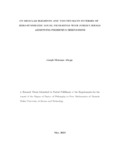ON REGULAR ELEMENTS AND VON-NEUMANN INVERSES OF ZERO-SYMMETRIC LOCAL NEAR-RINGS WITH JORDAN IDEALS ADMITTING FROBENIUS DERIVATIONS
Abstract
The study of near-rings with identity is very vital in generalizing characterization of
commutative rings with identity. Much of the recent works on the classification of
finite rings with identity have considered a characterization paradigm using the unit
groups, the zero divisor graphs, adjacency and incidence matrices among others.
This has left the non-linear aspects fairly untouched. In particular, regular elements
and Von-Neumann inverses of near rings admitting derivations hardly exist in literature.
Thus, the study determined the structures of classes of zero symmetric local
near rings N with n−nilpotent radical of Jordan ideals, J(N); n = 2, n ≥ 3 with
char N as p, p2 and pk; k ≥ 3 convoluted with Frobenius derivations, the commutation
over N constructed and finally characterized N,R(N), Γ(N) and the inverses
of N. To achieve these, the research used idealization of R0-modules with respect to
Galois rings and Raghavendran’s characterization method to construct the classes
of near-rings under investigation, the theorems of Asma and Inzamam to determine
the commutation over N via J(N) and the Frobenius derivations, the fundamental
theorem of finitely generated abelian groups to determine the structures of R(N)
and their inverses and SONATA. The results of this study showed two constructions
of classes of zero symmetric local near rings with a Jordan ideal containing
a 2-nilpotent radical which admit a commuting Frobenius derivation, determined
some graph morphisms which form symmetric groups, the regular elements obtained
have structures isomorphic to cyclic groups. The Von-Neumann inverses of
the N formulated agreed with the number theoretic standards of the Von-Neumann
inverses of idealized local rings while the arithmetic function, V (| R(N) |) followed
the asymptotic properties of V (n), τ (n), ω(n), σ(n) and K(n). Furthermore, the
results determined the automorphisms of R(N both in terms of structures and
orders.
Collections
- School of Education [45]

